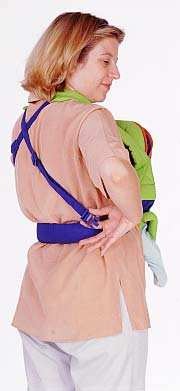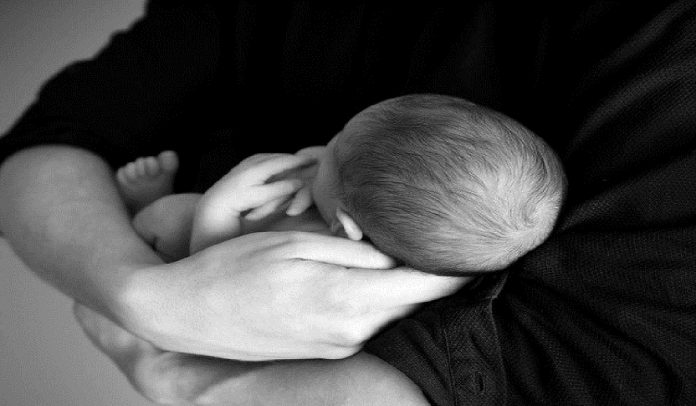There are many ways to hold a baby. The most common is to hold it as if you were about to rock it. If you hold him like this, you must still support his neck and neck with one hand. His muscles are still too weak for him to do it himself.
Don’t worry, you’ll be happy at how much your paternal instinct will take over once your baby is born.
WHAT IS THE SAFEST WAY TO HOLD A BABY?
The best way to hold a baby is the one that comes to you, but always make sure you support her head. She has no head control yet and will feel insecure without support.
A young baby likes to be able to see your face, which she can do if you hold her in one arm close to your side. Research suggests that babies prefer to be held on their parent’s left arm. This may be because the baby can feel and hear your heartbeat.
You and your baby will try a whole series of different positions, and even invent one of your own!
The most important thing is to always remember to support your head until you are able to do it yourself.
NEVER shake your baby
Never shake your baby, and never throw him into the air. Although it may appear to be appreciated, it can cause serious injury or even death to your child.
At birth, baby’s muscles are not developed enough to keep his head straight. As his neck is fragile, it is very important to take him and always support his head.
Week after week, baby strengthens his muscles to finally be able to control his movements.
To make your baby feel safe in your arms, take him with confidence.
Talk to your child when you approach to pick him up. Otherwise, he may be surprised and start crying if you lift him up.
- The vertical position
This is a position most often appreciated by babies. It allows them to see and observe what surrounds them. Why don’t you hold a baby against you, on your shoulder? Remember to support his neck and head with one hand.
- The lying position on your back
This is about holding the baby in your arms in a lying position as if you were about to rock him.
His head should not hang in the void (his muscles are not yet developed). So place his neck in the palm of your arm, while supporting his back with the other.
- The sitting position
For this position, hold it seated on your forearm, facing outwards. Wrap your second arm around her belly and chest. If you are sitting yourself, put your baby on your thigh.
- The belly position
Place the baby’s back on your stomach, grasp the right thigh with your left hand, gently tip it over your forearm, and face out. This position is comfortable for an infant and has the advantage of leaving one hand free even when moving.
How Can I Feel More Confident About Handling My Baby?
Try to relax. Confidence will come as you grow more accustomed to handling your baby and settle into your new role as a parent. Before you know it, you will feel at ease and develop your own way of handling her.
What Is The Safest Way To Carry a baby When I ’ M Walking Around?
Support her, and make sure you watch where you’re going. She’s vulnerable if you fall, and some babies have been known to break a leg when their parents tripped.
Don’t carry your baby in your arms if you are walking down the street, especially if it is dark or crowded use a sling.
My Partner is afraid He’ll Hurt Her By Picking Her Up. Is He Right?
Adults who aren’t used to babies often worry that they might squash the new arrival with inexpert handling,
but your partner is unlikely to hurt her as long as he remembers to support her head, and not to rush.
If he cares for her, your baby will sense this. Let him handle her without
Does It Matter If Lots Of Different People Hold Her?
It doesn’t matter as long as they all know how to hold a baby and transfer her. Remind people to support her head. Do not be shy about giving a demonstration; most grandparents have gotten out of the habit of holding babies.
As her parent, you are (or soon will be) the expert on the subject of your baby. Explain how she likes to be held. Hand her over. Try not to dump her onto someone’s lap or into their arms. Take your baby back when you think she’s had enough.
My Newborn Won’t Let Me Put Him Down, I Can’t Get Anything Done. What Can I Do?
Before birth, some people think that their baby can go in a backpack to the office, or lie in a bassinet for hours.
But, face facts: you’re not going to be able to do this. The reality is that your baby needs you, as well as food, warmth, and diaper changes.
Even everyday activities like brushing your teeth might be different now.
Yet, you will manage, albeit at a different pace. Even a long, relaxing bath may have to wait until your baby has been fed, changed, and is fast asleep.
Can I carry my baby around with me?
You will learn to do many things with your baby balanced on your shoulder and stabilized with one arm. Not everything can be done like this, but a sling can solve some of the problems.
How can I cope?
You will have to ditch some activities that aren’t necessary and accept help. Don’t be too ambitious. If you start a big task, your baby is guaranteed to wake up and howl for attention.
How Should I Handle My Baby?
Many first-time parents are unsure about how to hold their new baby. The techniques below will help guide you, but holding and handling will soon come.
Picking Your Baby Up

How to prepare your Newborn Baby checklist – Get Equipped now
| Place one hand under your baby’s head and neck, and the other under her bottom. | 2. Lift her slowly, close to your body, continuing to support and cradle her with your hands. | 3. Turn her toward your chest and shoulders as you straighten your back. |
Holding Your Baby
You can hold the baby in several positions, the best being the one that is most comfortable and natural for you both. Your baby will need to feel secure, whether she’s cradled in the crook of your elbow, held upright against your chest, or even held face down in your arms.

| ON YOUR SHOULDERPut one hand under her bottom to take her weight and support her head with your other hand. | ON YOUR ARM, FACING YOU Cradle your baby’s head in the crook of your elbow, and support her bottom with your other hand. | ON YOUR ARM, FACING DOWN Lay your baby along your forearm with one hand under her and the other supporting her body. |


How Do I Use a baby Sling?
A sling on your front can be used almost immediately, as long as it is not too big for your baby and her head is supported. Many slings have head supports built-in.
If you plan to use a sling, later on, get your baby used to one in the first six weeks.
for twins, a sling can still be useful for carrying one baby when the other one is asleep or you and your partner can carry one baby each.
Your baby will probably not want to be in a sling for too long. To begin with, half an hour might be her limit, but this will lengthen as she gets older.
How Do I Put My Baby In a Sling?

- Put the sling down in an open position on a sofa or bed and place your baby on her back on top of it.

2. Gently ease her legs into the leg holes in the sling. Sit down and gather the baby and sling to you, at a height where you are able to kiss the top of her head.

3. Holding your baby securely, pull the straps over your shoulders and tie the buckle firmly. The fastening may be on the side or back, so you may need another adult to help you. Stand up when your baby is fully strapped in. Make sure that your baby’s legs are supported, but not squashed or cramped.
Can I Make A Baby Sling?
If necessary, you can make a sling from a crib sheet or a piece of strong fabric, measuring about 3 x 6 ft (1 x 2 m). Drape the fabric over one shoulder, ideally your left, and tie the ends together with a strong knot at the opposite hip. Rotate the sling so that the knot is at your back.
Then gently ease your baby into the pouch made at the front by the rest of the material. Make sure that she is held securely against your chest and cannot fall out.


How to hold a baby to breastfeed
Breastfeeding is often, beyond its purely nutritional value, a real moment of pleasure for mothers and babies. But if it is spoiled by pain or cracks, everything can be called into question.
To avoid this, it is important to hold your baby properly while breastfeeding. How to hold your baby well when breastfeeding? We’ll give you some leads.
1- Make yourself comfortable
- Armchairs, sofas, beds, or even on the floor, no matter where you finally settle. What matters most is that you find it comfortable. If you are not well settled, if your back hurts (or elsewhere) in the chosen position, the baby will also feel it, and will be less comfortable during the feeding.
- Be as relaxed as possible, without muscle tension.
- Get deep enough into your seat and wedge your lower back with cushions if necessary.
- Place your baby facing you, he must be completely facing you, his stomach against yours, his head lodged in the hollow of your elbow. This position is the most common.
- Use pillows or a breastfeeding cushion to hold your baby if you have trouble holding him or her or if he or she is too heavy. The important thing is really to focus on comfort for both of you and the ease with which baby can suck.
2- Adopt the right position
There are several ways to hold a baby. Again, there is no way to do it right. Above all, you must find the right position for you and your baby. Nevertheless, here are the main positions you can test:
- place your baby facing you, belly to belly, his head in the hollow of your elbow, your arm resting on an armrest or a cushion.


- The “rugby ball” position: place your baby on your waist, with his head resting in your hand (a bit like holding a rugby ball). This position is mainly used in post-partum care, especially after a cesarean section.

- Lying down: lie down, with your head cushioned, and place your baby in front of you. This position is ideal for night feedings.
Important: When you hold a baby, smile at her and talk to her. This will help her feel secure. Hold her close as you pick her up and put her down.




